The Failure Mechanical Properties of Cemented Paste Backfill with Recycled Rubber
Abstract
1. Introduction
2. Experimental Program
2.1. Materials
2.2. Experimental Design
2.3. Specimen Preparation
- The raw materials were weighed according to the design table, see Table 1;
- The solid material was poured into the stirring container and stirred for 2 min at a speed of 75 r/min;
- Water was poured into the stirring container and stirred for 5 min at a speed of 75 r/min.
2.4. Methods
2.4.1. UCS Test
2.4.2. UPV Test
2.4.3. DIC Monitoring
3. Results
3.1. The UCS and UPV
3.2. Peak Strain and Toughness
3.3. Failure Process
4. Conclusions
- Although the UCS of RCPB is reduced as a result of the rubber, its peak strain and toughness are increased. The strength of the specimens in this study decreased by 15.7% after curing for 28 days, when the rubber content was increased from 0 to 4%. Moreover, the peak strain of the specimens increased by 82.5%, and the toughness of the specimens increased by 38%. This means that RCPB has better deformability, and the impact resistance of CPB can be increased with the addition of rubber. Increasing the impact resistance of RCPB can be achieved by designing its strength and toughness reasonably.
- The UPV of RCPB decreases with an increase in its rubber content. There is an exponential function relationship between the UCS and the UPV of RCPB: the lower the wave speed, the lower the intensity. The main reason for this is that the UPV of rubber is relatively low. The propagation of the ultrasonic longitudinal wave in RCPB is also affected by the weak interface between the rubber and the filling matrix.
- The fracture process of RCPB is divided into the following four main stages: the original crack compaction stage, the linear elastic stage, the plastic yield stage, and the post-peak failure stage. DIC technology was used to observe the local strain field of the specimens in this study. The stress–strain curve of the RCPB specimens were significantly different from the control specimen without rubber. The strain corresponding to the plastic-yielding stage increased as the rubber content increased. The ductility of RCPB was also greatly enhanced.
- The specimens with added rubber mainly exhibited “X”-type failure. Since the rubber increased the toughness of the filled body, the filled body cracked but did not break. Furthermore, the residual strengths of the RCPB specimens were proportionally higher.
Author Contributions
Funding
Data Availability Statement
Conflicts of Interest
References
- Yilmaz, E. Advances in Reducing Large Volumes of Environmentally Harmful Mine Waste Rocks and Tailings. Gospod. Surowcami Miner.-Miner. Resour. Manag. 2011, 27, 89–112. [Google Scholar]
- Li, T.; Wang, X.L.; Li, M.; Nan, D.Y.; Shan, Q.Y.; Chen, W.X. Synergy Between Suspending Agent and Air Entraning Agent in Cement Slurry. Rev. Romana Mater.-Rom. J. Mater. 2020, 50, 344–353. [Google Scholar]
- Yang, L.J.; Hou, C.; Zhu, W.C.; Liu, X.G.; Yan, B.X.; Li, L. Monitoring the failure process of cemented paste backfill at different curing times by using a digital image correlation technique. Constr. Build. Mater. 2022, 346, 128487. [Google Scholar] [CrossRef]
- Zhao, W.; Ji, C.; Sun, Q.; Gu, Q. Preparation and Microstructure of Alkali-Activated Rice Husk Ash-Granulated Blast Furnace Slag Tailing Composite Cemented Paste Backfill. Materials 2022, 15, 4397. [Google Scholar] [CrossRef]
- Zhou, Y.; Fall, M. Mechanical and Microstructural Properties of Cemented Paste Backfill with Chloride-Free Antifreeze Additives in Subzero Environments. J. Mater. Civ. Eng. 2023, 35, 04023148. [Google Scholar] [CrossRef]
- Li, L.; Pengyu, Y. A numerical evaluation of continuous backfilling in cemented paste backfilled stope through an application of wick drains. Int. J. Min. Sci. Technol. 2015, 25, 897–904. [Google Scholar] [CrossRef]
- Zhao, Y.; Taheri, A.; Karakus, M.; Chen, Z.W.; Deng, A. Effects of water content, water type and temperature on the rheological behaviour of slag-cement and fly ash-cement paste backfill. Int. J. Min. Sci. Technol. 2020, 30, 271–278. [Google Scholar] [CrossRef]
- Kou, Y.P.; Jiang, H.Q.; Ren, L.; Yilmaz, E.; Li, Y.H. Rheological Properties of Cemented Paste Backfill with Alkali-Activated Slag. Minerals 2020, 10, 288. [Google Scholar] [CrossRef]
- Yang, B.; Wang, X.; Yin, P.; Gu, C.; Yin, X.; Yang, F.; Li, T. The Rheological Properties and Strength Characteristics of Cemented Paste Backfill with Air-Entraining Agent. Minerals 2022, 12, 1457. [Google Scholar] [CrossRef]
- Alireza, G.; Mamadou, F. Strength evolution and deformation behaviour of cemented paste backfill at early ages: Effect of curing stress, filling strategy and drainage. Int. J. Min. Sci. Technol. 2016, 26, 809–817. [Google Scholar]
- Yang, P.; Li, L. Investigation of the short-term stress distribution in stopes and drifts backfilled with cemented paste backfill. Int. J. Min. Sci. Technol. 2015, 25, 721–728. [Google Scholar]
- Xu, W.B.; Zhang, Y.L.; Liu, B. Influence of silica fume and low curing temperature on mechanical property of cemented paste backfill. Constr. Build. Mater. 2020, 254, 119305. [Google Scholar] [CrossRef]
- Huang, Z.Q.; Yilmaz, E.; Cao, S. Analysis of Strength and Microstructural Characteristics of Mine Backfills Containing Fly Ash and Desulfurized Gypsum. Minerals 2021, 11, 409. [Google Scholar] [CrossRef]
- Wang, J.; Fu, J.X.; Song, W.D.; Zhang, Y.F. Effect of rice husk ash (RHA) dosage on pore structural and mechanical properties of cemented paste backfill. J. Mater. Res. Technol. 2022, 17, 840–851. [Google Scholar] [CrossRef]
- Chen, X.; Shi, X.Z.; Zhou, J.; Li, E.M.; Qiu, P.Y.; Gou, Y.G. High strain rate compressive strength behavior of cemented paste backfill using split Hopkinson pressure bar. Int. J. Min. Sci. Technol. 2021, 31, 387–399. [Google Scholar] [CrossRef]
- Xiu, Z.; Wang, S.; Ji, Y.; Wang, F.; Ren, F.; Nguyen, V.-T. Loading rate effect on the uniaxial compressive strength (UCS) behavior of cemented paste backfill (CPB). Constr. Build. Mater. 2021, 271, 121526. [Google Scholar] [CrossRef]
- Eker, H.; Bascetin, A. Influence of silica fume on mechanical property of cemented paste backfill. Constr. Build. Mater. 2022, 317, 126089. [Google Scholar] [CrossRef]
- Wang, H.; Zhao, X.; Zhou, B.; Lin, Y.; Gao, H. Performance Optimization and Characterization of Soda Residue-Fly Ash Geopolymer Paste for Goaf Backfill: Beta-Hemihydrate Gypsum Alternative to Sodium Silicate. Materials 2020, 13, 5604. [Google Scholar] [CrossRef]
- Fang, K.; Yang, J.X.; Wang, Y.J. Comparison of the mode I fracture toughness of different cemented paste backfill-related structures: Effects of mixing recipe. Eng. Fract. Mech. 2022, 270, 108579. [Google Scholar] [CrossRef]
- Wang, H.; Qi, T.; Feng, G.; Wen, X.; Wang, Z.; Shi, X.; Du, X. Effect of partial substitution of corn straw fly ash for fly ash as supplementary cementitious material on the mechanical properties of cemented coal gangue backfill. Constr. Build. Mater. 2021, 280, 122553. [Google Scholar] [CrossRef]
- Sun, Q.; Wei, X.; Li, T.; Zhang, L. Strengthening Behavior of Cemented Paste Backfill Using Alkali-Activated Slag Binders and Bottom Ash Based on the Response Surface Method. Materials 2020, 13, 855. [Google Scholar] [CrossRef]
- Sun, Q.; Li, T.; Liang, B. Preparation of a New Type of Cemented Paste Backfill with an Alkali-Activated Silica Fume and Slag Composite Binder. Materials 2020, 13, 372. [Google Scholar] [CrossRef]
- Zhao, Y.; Taheri, A.; Soltani, A.; Karakus, M.; Deng, A. Strength Development and Strain Localization Behavior of Cemented Paste Backfills Using Portland Cement and Fly Ash. Materials 2019, 12, 3282. [Google Scholar] [CrossRef] [PubMed]
- Cao, S.; Yilmaz, E.; Song, W.D. Fiber type effect on strength, toughness and microstructure of early age cemented tailings backfill. Constr. Build. Mater. 2019, 223, 44–54. [Google Scholar] [CrossRef]
- Zhou, N.; Du, E.B.; Zhang, J.X.; Zhu, C.L.; Zhou, H.Q. Mechanical properties improvement of Sand-Based cemented backfill body by adding glass fibers of different lengths and ratios. Constr. Build. Mater. 2021, 280, 122408. [Google Scholar] [CrossRef]
- Wang, H.C.; Feng, G.R.; Qi, T.Y.; Gao, X.Y.; Wang, C.Y.; Wang, L.F.; Zhang, Z.C. Influence of the use of corn straw fibers to connect the interfacial transition zone with the mechanical properties of cemented coal gangue backfill. Constr. Build. Mater. 2023, 367, 130334. [Google Scholar] [CrossRef]
- Li, Z.; Shi, X.; Chen, X. Effect of Rice Straw on Tensile Properties of Tailings Cemented Paste Backfill. Appl. Sci. 2022, 12, 526. [Google Scholar] [CrossRef]
- Yin, S.H.; Yan, Z.P.; Chen, X.; Wang, L.M. Effect of fly-ash as fine aggregate on the workability and mechanical properties of cemented paste backfill. Case Stud. Constr. Mater. 2022, 16, e01039. [Google Scholar] [CrossRef]
- Feng, Y.B.; Li, F.; Qi, W.Y.; Ren, Q.S.; Qi, W.Y.; Duan, G.; Zheng, K.L.; Han, Y.J.; Pang, H.T. Mechanical Properties and Microstructure of Iron Tailings Cemented Paste Backfills Using Carbide Slag-Activated Ground Granulated Blast-Furnace Slag as Alternative Binder. Minerals 2022, 12, 1549. [Google Scholar] [CrossRef]
- Hu, Y.; Li, K.; Zhang, B.; Han, B. Development of Cemented Paste Backfill with Superfine Tailings: Fluidity, Mechanical Properties, and Microstructure Characteristics. Materials 2023, 16, 1951. [Google Scholar] [CrossRef]
- Jin, J.; Qin, Z.; Zuo, S.; Feng, J.; Sun, Q. The Role of Rheological Additives on Fresh and Hardened Properties of Cemented Paste Backfill. Materials 2022, 15, 3006. [Google Scholar] [CrossRef] [PubMed]
- Zhaowen, D.; Shaojie, C.; Dawei, Y.; Dehao, Y.; Zhen, Z. Experimental study of stability of paste backfill under chloride erosion environment. J. Min. Sci. Technol. 2021, 50, 532–538+547. (In Chinese) [Google Scholar]
- Song, J.J.; Xu, M.B.; Liu, W.H.; Wang, X.H.; Xu, P.L.; Huang, F.; Pan, Y.G. Thermoplastic Rubber (TPR) Modified by a Silane Coupling Agent and Its Influence on the Mechanical Properties of Oil Well Cement Pastes. Adv. Mater. Sci. Eng. 2019, 2019, 3587081. [Google Scholar] [CrossRef]
- Alyousef, R.; Ahmad, W.; Ahmad, A.; Aslam, F.; Joyklad, P.; Alabduljabbar, H. Potential use of recycled plastic and rubber aggregate in cementitious materials for sustainable construction: A review. J. Clean. Prod. 2021, 329, 129736. [Google Scholar] [CrossRef]
- Nuzaimah, M.; Sapuan, S.; Nadlene, R.; Jawaid, M. Recycling of waste rubber as fillers: A review. In Proceedings of the IOP Conference Series: Materials Science and Engineering, Kuala Lumpur, Malaysia, 13–14 August 2018; p. 012016. [Google Scholar]
- Ma, Y.T.; Wang, S.F.; Zhou, H.Y.; Hu, W.; Polaczyk, P.; Zhang, M.M.; Huang, B.S. Compatibility and rheological characterization of asphalt modified with recycled rubber-plastic blends. Constr. Build. Mater. 2021, 270, 121416. [Google Scholar] [CrossRef]
- Lv, J.; Du, Q.; Zhou, T.H.; He, Z.Q.; Li, K.L. Fresh and Mechanical Properties of Self-Compacting Rubber Lightweight Aggregate Concrete and Corresponding Mortar. Adv. Mater. Sci. Eng. 2019, 2019, 8372547. [Google Scholar] [CrossRef]
- Depaolini, A.R.; Bianchi, G.; Fornai, D.; Cardelli, A.; Badalassi, M.; Cardelli, C.; Davoli, E. Physical and chemical characterization of representative samples of recycled rubber from end-of-life tires. Chemosphere 2017, 184, 1320–1326. [Google Scholar] [CrossRef]
- Wang, Y.Y.; Yu, Z.Q.; Wang, H.W. Experimental investigation on some performance of rubber fiber modified cemented paste backfill. Constr. Build. Mater. 2021, 271, 121586. [Google Scholar] [CrossRef]
- Xiao, B.L.; Huang, H.T.; Zhang, J.Y. A Green Sintering-Free Binder Material with High-Volumetric Steel Slag Dosage for Mine Backfill. Minerals 2022, 12, 1036. [Google Scholar] [CrossRef]
- Zhao, K.; Yu, X.; Zhu, S.; Zhou, Y.; Wang, Q.; Wang, J. Acoustic emission investigation of cemented paste backfill prepared with tantalum–niobium tailings. Constr. Build. Mater. 2020, 237, 117523. [Google Scholar] [CrossRef]
- Tang, R.; Zhao, B.; Tian, C.; Xu, B.; Li, L.; Shao, X.; Ren, W. Preliminary Study of Preheated Decarburized Activated Coal Gangue-Based Cemented Paste Backfill Material. Materials 2023, 16, 2354. [Google Scholar] [CrossRef]
- Shi, X.; Zhao, Z.; Chen, X.; Kong, K.; Yuan, J. Investigation of Fluidity and Strength of Enhanced Foam-Cemented Paste Backfill. Materials 2022, 15, 7101. [Google Scholar] [CrossRef]
- Wang, Y.M.; Wu, J.Y.; Pu, H.; Chen, W.Q.; Yin, Q.; Yang, S.; Ma, D. Effect of interface geometric parameters on the mechanical properties and damage evolution of layered cemented gangue backfill: Experiments and models. Constr. Build. Mater. 2022, 349, 128678. [Google Scholar] [CrossRef]
- Ghirian, A.; Fall, M. Coupled behavior of cemented paste backfill at early ages. Geotech. Geol. Eng. 2015, 33, 1141–1166. [Google Scholar] [CrossRef]
- Yang, F.; Wu, F.; Yang, B.; Li, L.; Gao, Q. Preparation and performance of composite activated slag-based binder for cemented paste backfill. Chemosphere 2022, 309, 136649. [Google Scholar] [CrossRef]
- Li, K.; Li, X.; Du, C.; Xue, H.; Sun, Q.; Liu, L. Experimental Study on Microstructure and Erosion Mechanisms of Solid Waste Cemented Paste Backfill under the Combined Action of Dry-Wet Cycles and Sulphate Erosion. Materials 2022, 15, 1484. [Google Scholar] [CrossRef] [PubMed]
- Singalreddy, S.P.; Cui, L.; Fang, K. Spatiotemporal evolution of thermo-hydro-mechanical-chemical processes in cemented paste backfill under interfacial loading. Int. J. Min. Sci. Technol. 2022, 32, 1207–1217. [Google Scholar] [CrossRef]
- Fall, M.; Belem, T.; Samb, S.; Benzaazoua, M. Experimental characterization of the stress–strain behaviour of cemented paste backfill in compression. J. Mater. Sci. 2007, 42, 3914–3922. [Google Scholar] [CrossRef]
- Lu, H.; Sun, Q. Preparation and Strength Formation Mechanism of Calcined Oyster Shell, Red Mud, Slag, and Iron Tailing Composite Cemented Paste Backfill. Materials 2022, 15, 2199. [Google Scholar] [CrossRef]
- Li, Y.; Ni, W.; Gao, W.; Zhang, S.; Fu, P.; Li, Y. Study on Solidification and Stabilization of Antimony-Containing Tailings with Metallurgical Slag-Based Binders. Materials 2022, 15, 1780. [Google Scholar] [CrossRef]
- Xu, S.; Suorineni, F.T.; Li, K.M.; Li, Y.H. Evaluation of the strength and ultrasonic properties of foam-cemented paste backfill. Int. J. Min. Reclam. Environ. 2017, 31, 544–557. [Google Scholar] [CrossRef]
- Jiang, H.; Han, J.; Li, Y.; Yilmaz, E.; Sun, Q.; Liu, J. Relationship between ultrasonic pulse velocity and uniaxial compressive strength for cemented paste backfill with alkali-activated slag. Nondestruct. Test. Eval. 2020, 35, 359–377. [Google Scholar] [CrossRef]
- Qiu, J.P.; Guo, Z.B.; Yang, L.; Jiang, H.Q.; Zhao, Y.L. Effect of tailings fineness on flow, strength, ultrasonic and microstructure characteristics of cemented paste backfill. Constr. Build. Mater. 2020, 263, 120645. [Google Scholar] [CrossRef]
- Wang, B.; Li, L.; Yu, Y.; Huo, B.; Liu, J.; Liu, J. Analysis of damage failure in uniaxial compressive of cemented paste backfill by ultrasonic pulse velocity test. Rev. Int. Métodos Numéricos Cálculo Diseño Ing. 2021, 37, 27. [Google Scholar] [CrossRef]
- Zhao, K.; He, Z.; Yang, J.; Yan, Y.; Yu, X.; Zhou, Y.; Zhang, X.; Wang, J. Investigation of failure mechanism of cement-fiber-tailings matrix composites using digital image correlation and acoustic emission. Constr. Build. Mater. 2022, 335, 127513. [Google Scholar] [CrossRef]
- Wang, A.A.I.; Cao, S.; Yilmaz, E. Influence of types and contents of nano cellulose materials as reinforcement on stability performance of cementitious tailings backfill. Constr. Build. Mater. 2022, 344, 128179. [Google Scholar] [CrossRef]
- Jie, W.; Chi, Z.; Jianxin, F.; Weidong, S.; Yongfang, Z. Effect of water saturation on mechanical characteristics and damage behavior of cemented paste backfill. J. Mater. Res. Technol. 2021, 15, 6624–6639. [Google Scholar]

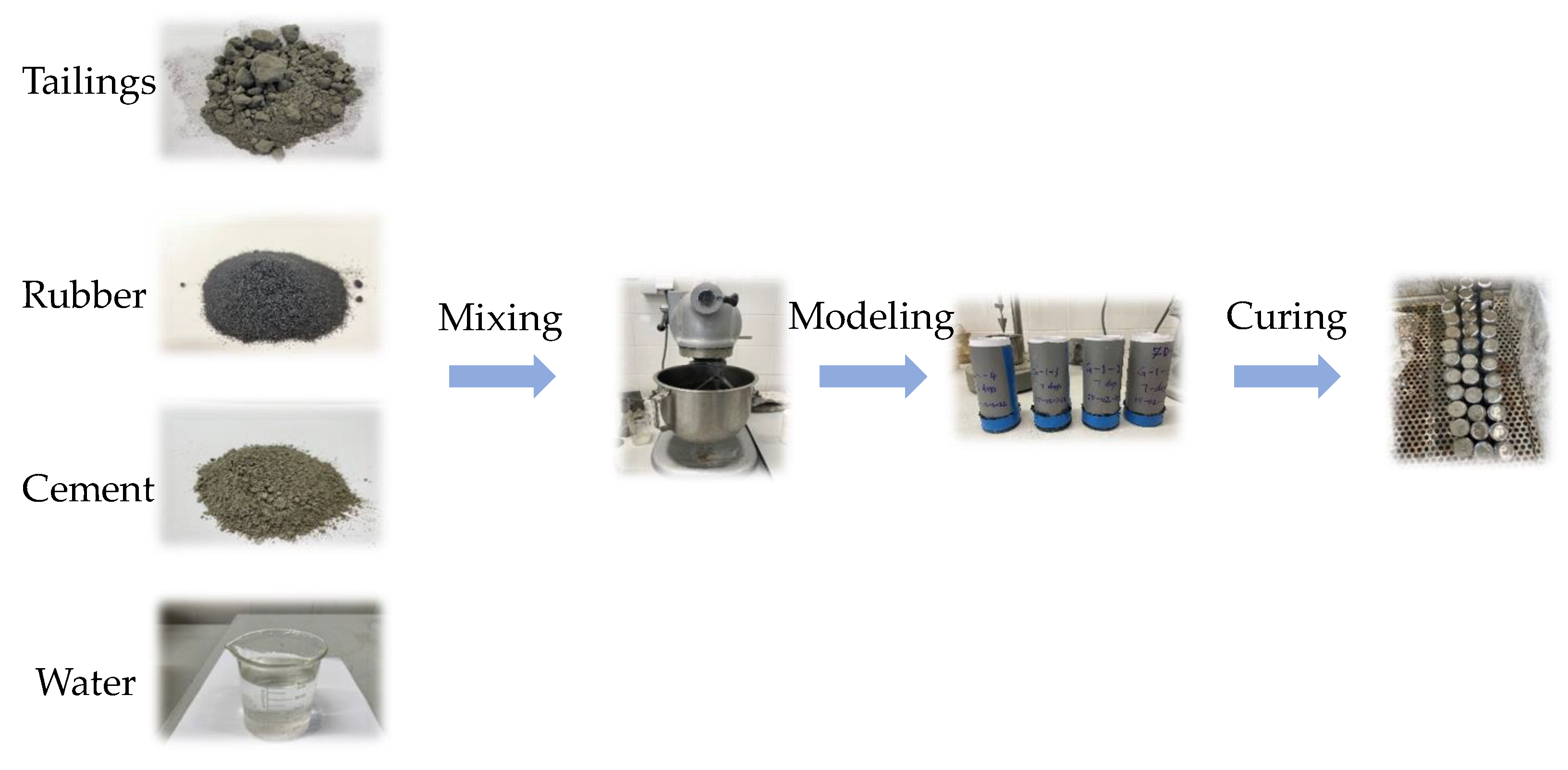
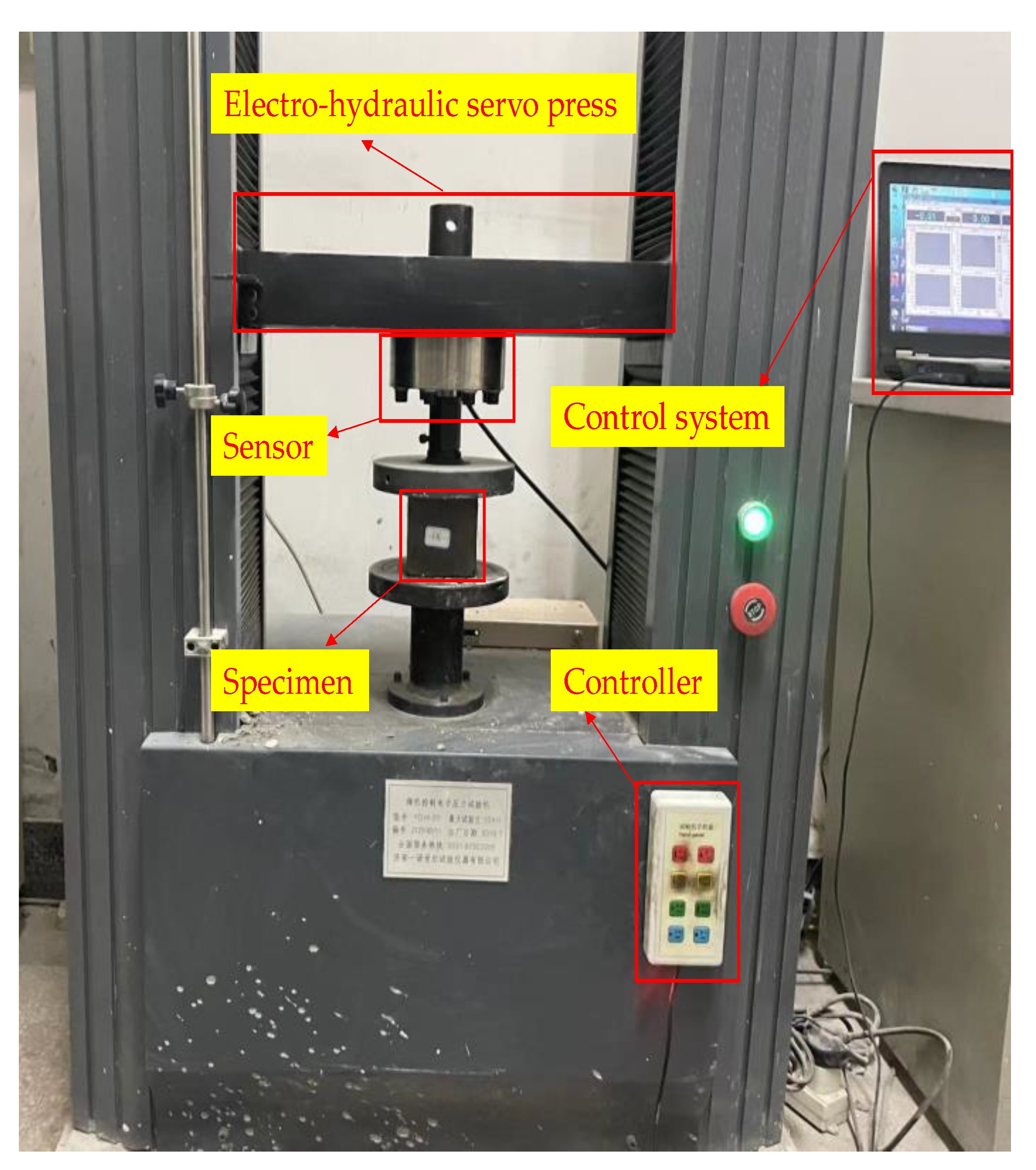
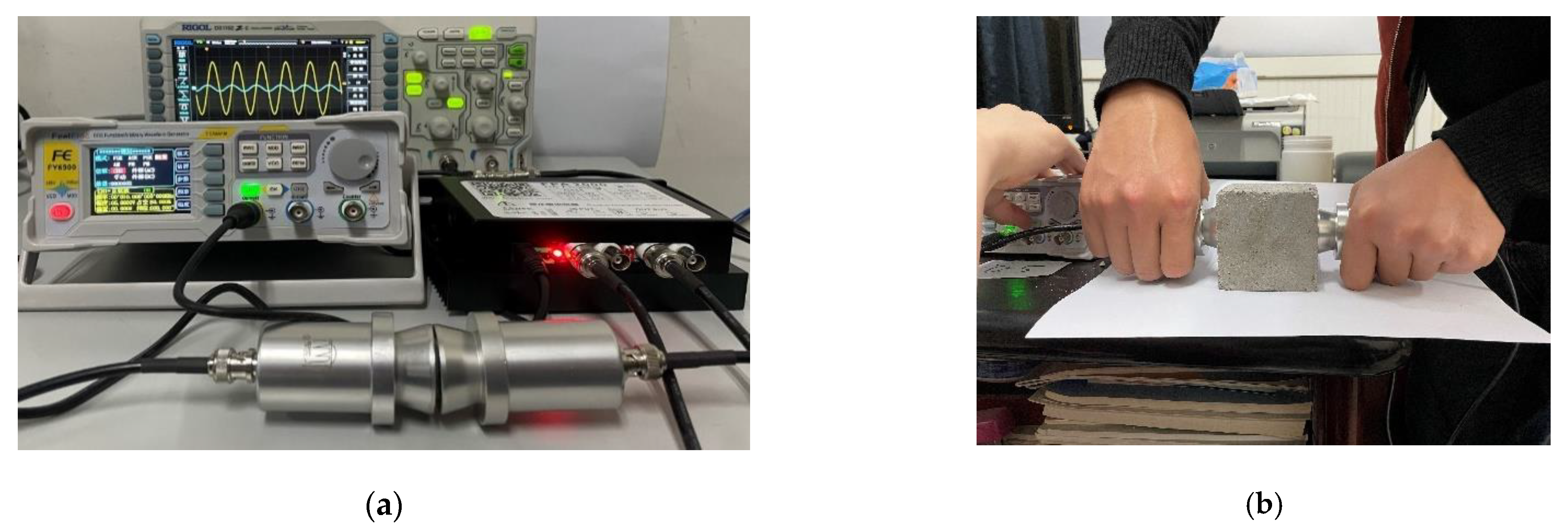
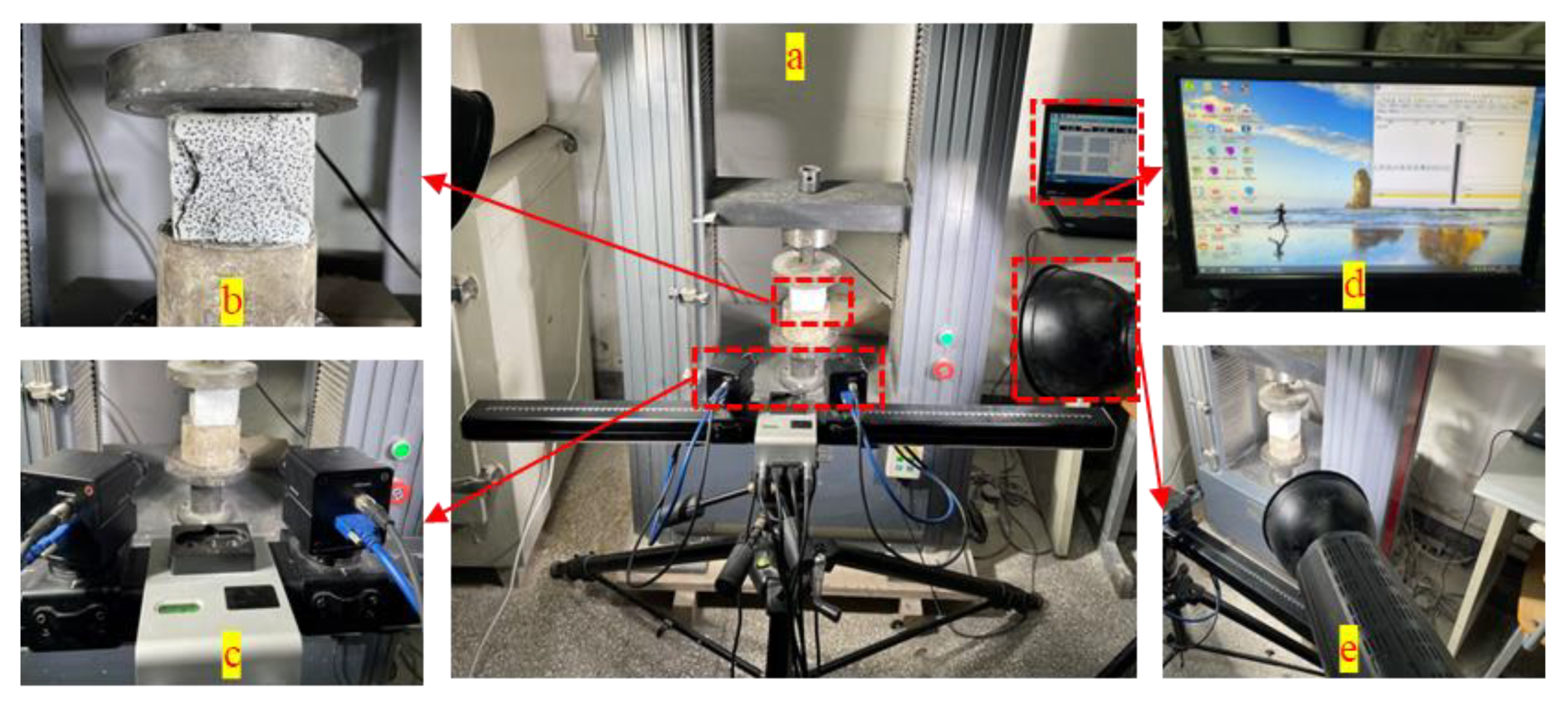
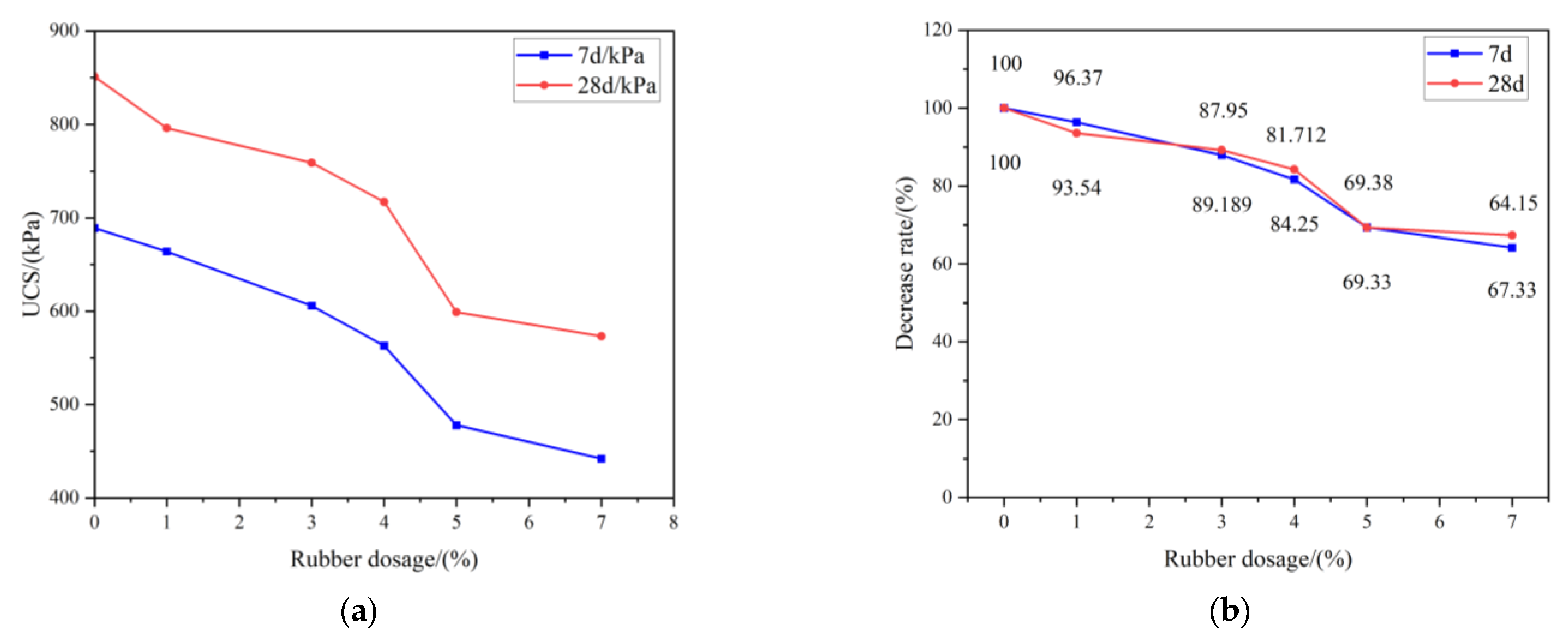

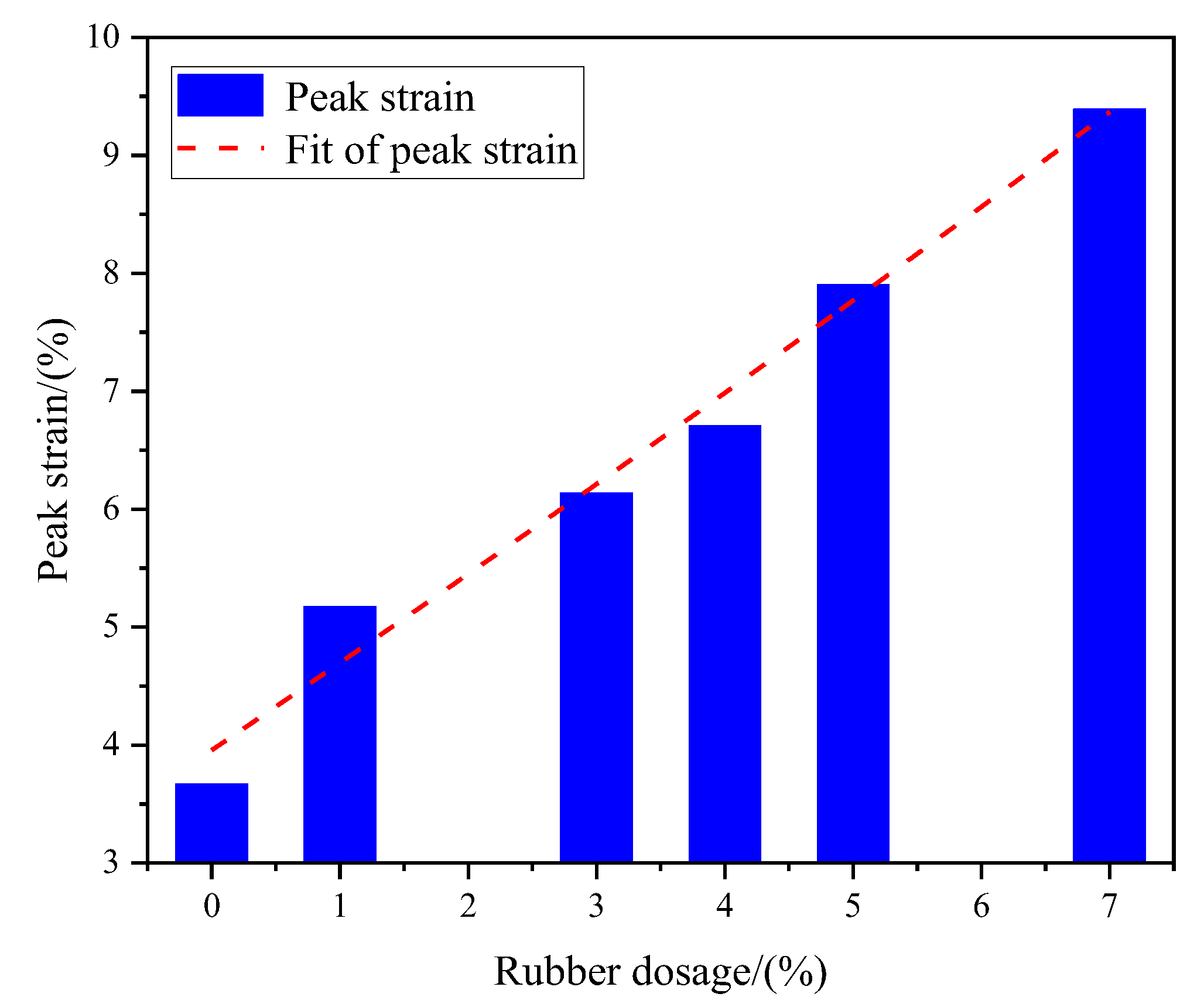

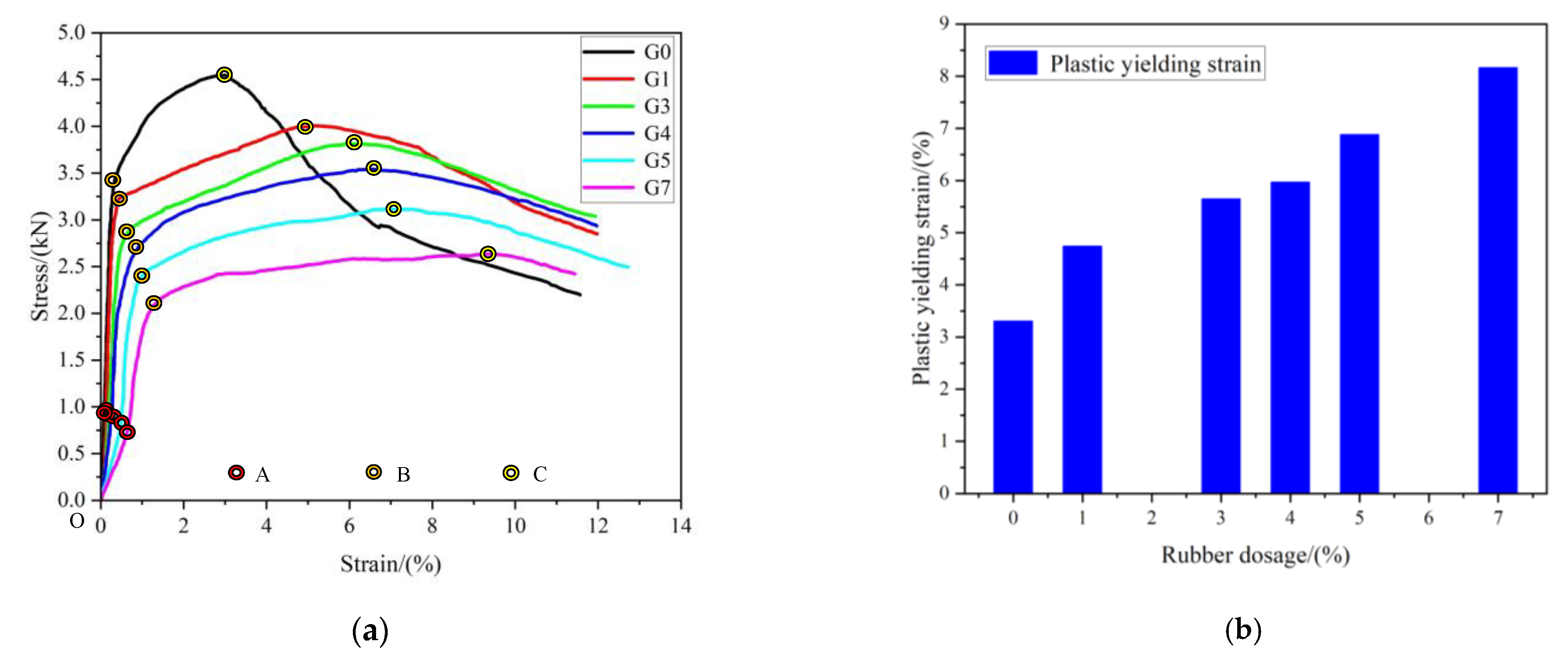
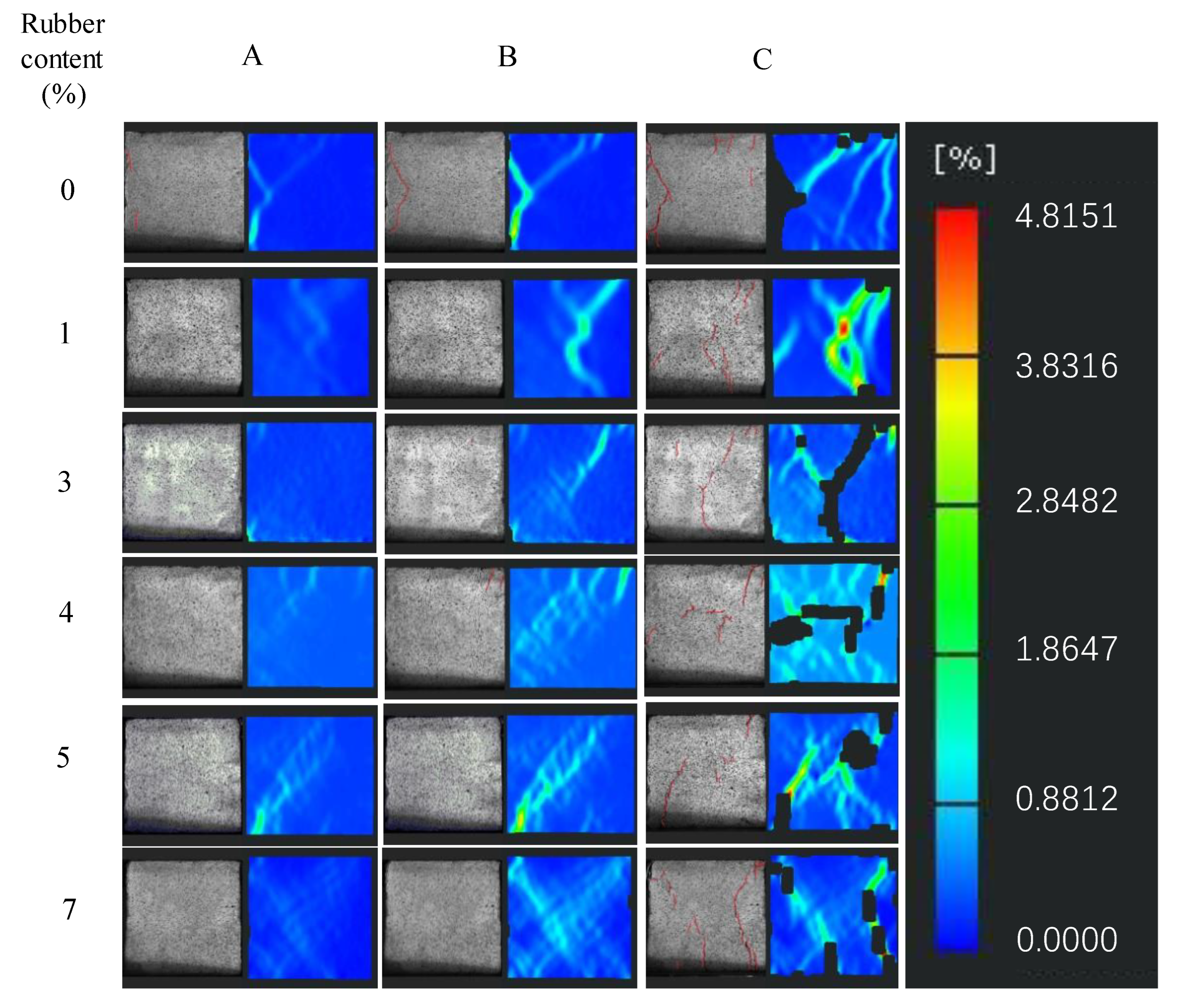
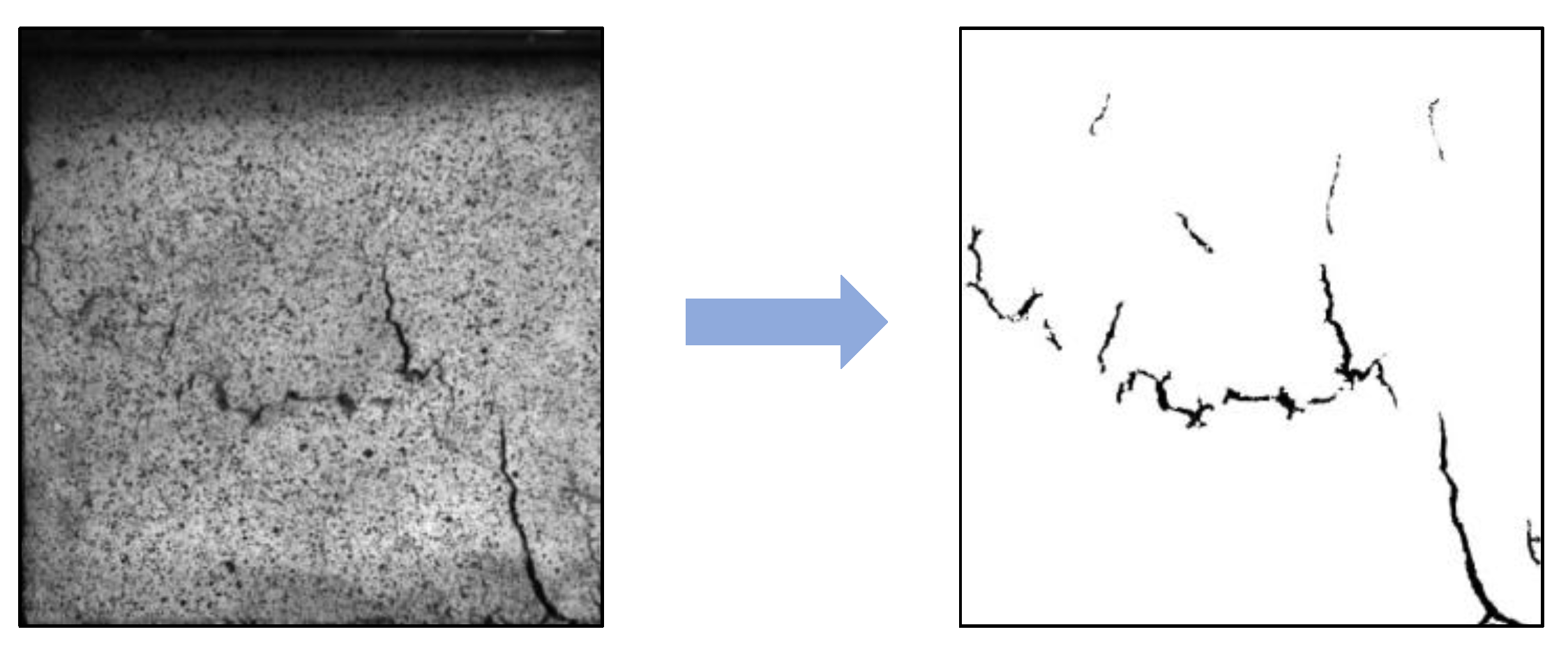

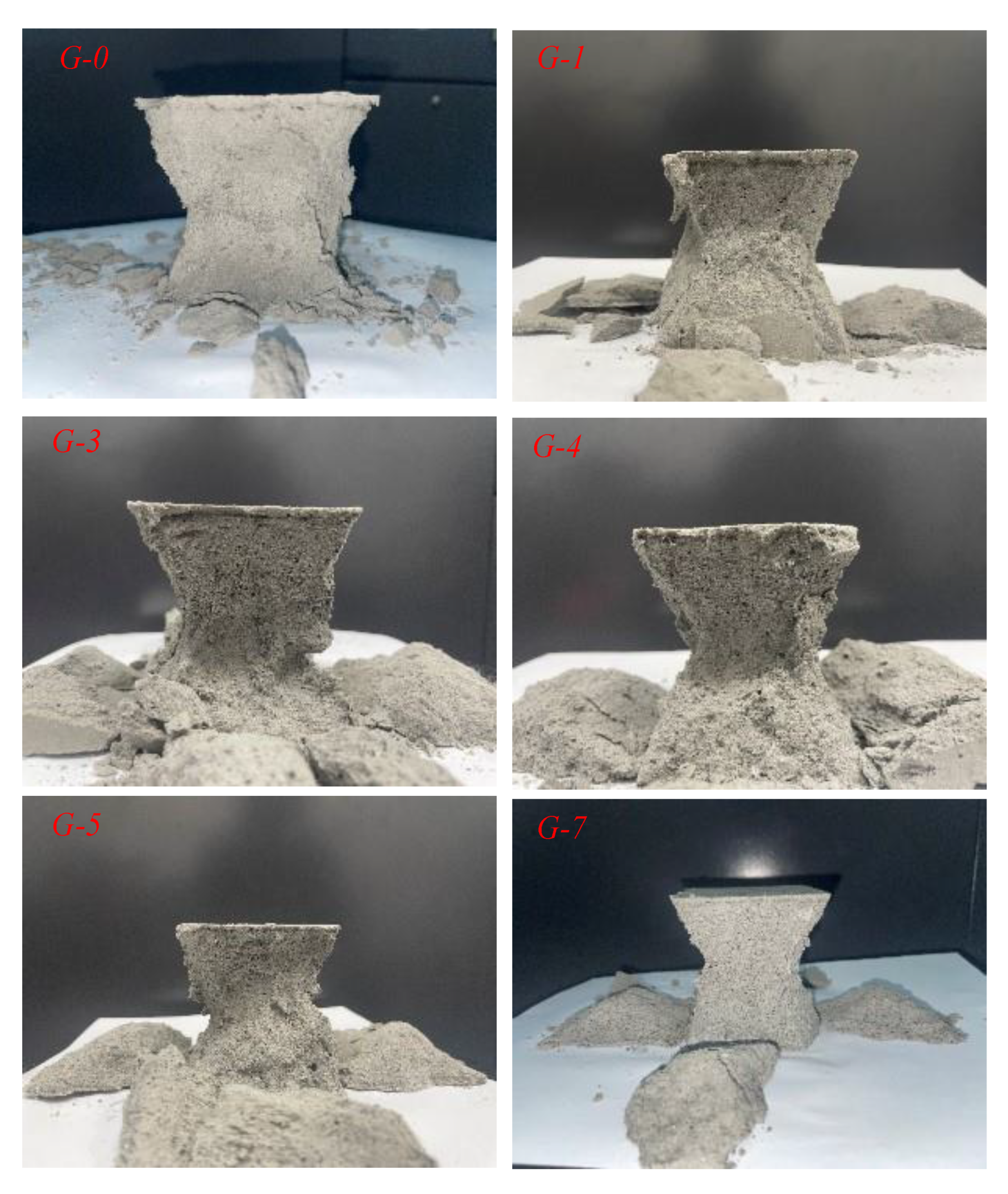
| Groups | Rubber (%) | Cement (%) | Tailings (%) | Water (%) |
|---|---|---|---|---|
| G-0 | 0.0 | 5.0 | 95.0 | 26.2 |
| G-1 | 1.0 | 5.0 | 94.0 | 26.2 |
| G-3 | 3.0 | 5.0 | 92.0 | 26.2 |
| G-4 | 4.0 | 5.0 | 91.0 | 26.2 |
| G-5 | 5.0 | 5.0 | 90.0 | 26.2 |
| G-7 | 7.0 | 5.0 | 88.0 | 26.2 |
Disclaimer/Publisher’s Note: The statements, opinions and data contained in all publications are solely those of the individual author(s) and contributor(s) and not of MDPI and/or the editor(s). MDPI and/or the editor(s) disclaim responsibility for any injury to people or property resulting from any ideas, methods, instructions or products referred to in the content. |
© 2023 by the authors. Licensee MDPI, Basel, Switzerland. This article is an open access article distributed under the terms and conditions of the Creative Commons Attribution (CC BY) license (https://creativecommons.org/licenses/by/4.0/).
Share and Cite
Yang, B.; Wang, X.; Gu, C.; Yang, F.; Liu, H.; Jin, J.; Zhou, Y. The Failure Mechanical Properties of Cemented Paste Backfill with Recycled Rubber. Materials 2023, 16, 3302. https://doi.org/10.3390/ma16093302
Yang B, Wang X, Gu C, Yang F, Liu H, Jin J, Zhou Y. The Failure Mechanical Properties of Cemented Paste Backfill with Recycled Rubber. Materials. 2023; 16(9):3302. https://doi.org/10.3390/ma16093302
Chicago/Turabian StyleYang, Baogui, Xiaolong Wang, Chengjin Gu, Faguang Yang, Hao Liu, Junyu Jin, and Yibo Zhou. 2023. "The Failure Mechanical Properties of Cemented Paste Backfill with Recycled Rubber" Materials 16, no. 9: 3302. https://doi.org/10.3390/ma16093302
APA StyleYang, B., Wang, X., Gu, C., Yang, F., Liu, H., Jin, J., & Zhou, Y. (2023). The Failure Mechanical Properties of Cemented Paste Backfill with Recycled Rubber. Materials, 16(9), 3302. https://doi.org/10.3390/ma16093302






